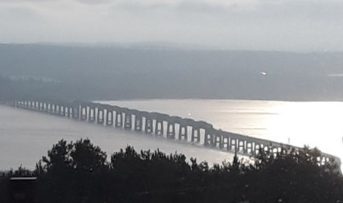Motorists have each saved thousands of pounds since The Courier’s victorious campaign to scrap bridge tolls.
Ten years ago today a law was passed that abolished charges for drivers using the Tay and Forth Road bridges.
The cost over the last decade for regular commuters travelling over the Tay would have been £2,020, compared with £2,530 for the Forth.
Those using both bridges for their trip to work are £4,550 better off than if they had continued to be stung by the charges to this day.
The Courier’s Scrap the Tolls campaign played a major part in convincing politicians to get on board with getting rid of the hated charges.
The SNP formed its historic first government in 2007 on a manifesto that pledged to remove the fees.
But as a minority administration it required support from other parties, which the campaign helped to build.
Humza Yousaf, the Transport Minister, said he is “hugely proud” of the Scottish Government’s “landmark decision” in its first year in office.
“Ten years on and this decision continues to save road users money, just as it has done for the last decade since tolls of this kind were abolished in Scotland,” he said.
The charge was £1 for crossing the Forth and 80p for the Tay.
Tricia Marwick, who was an SNP MSP for Fife, spent years campaigning on the issue.
The former presiding officer said she was driven by a “sense of unfairness” felt since childhood that Tayside and Fife motorists had to cough up to use the roads when other parts of the country did not.
Transport chiefs at Holyrood’s opposition parties agree that the fees should be consigned to history.
The Scottish Greens, whose two MSPs voted against the abolition of the charges in 2007, say they do not support a return to tolling.
John Finnie, the Green MSP, said: “Bridge tolls are not something we propose.
“Our transport priorities are the re-regulation of buses and a public sector bid for ScotRail, so passengers get cheaper fares and better services.
“We also need to see the government drop its daft policy of cutting aviation tax, as this cannot be justified on social, environmental or economic grounds.”
Scottish Conservative transport spokesman Jamie Greene said it would be “wrong” to make drivers in Tayside, Fife and the Lothians pay.
“Taxpayers played their part in the completion of the Queensferry Crossing, and of course support the upkeep of Forth and Tay bridges,” he said.
“Forcing them to pay tolls in addition to that would be unpopular and unnecessary.”
Scottish Labour’s Colin Smyth said: “Scotland’s bridges play a crucial role in connecting communities and driving economic growth.
“Scottish Labour does not support introducing tolls on any of Scotland’s bridges, including the Tay Road Bridge, Forth Road Bridge and Queensferry Crossing.”
Scottish Liberal Democrat Mike Rumbles said: “Tolls on the Tay and Forth bridges would have a huge detrimental impact on jobs and businesses across the region and increase congestion on our roads.
“Bridge tolls are gone and will not be coming back.”
Simon Williams, from the RAC motoring group, thinks Scotland’s lead on scrapping tolls should be followed elsewhere in the UK.
“Motorists in England will be envious that drivers in Scotland have enjoyed 10 years without having to pay bridge tolls,” he said.
“While there is an understanding that new bridges, tunnels and roads funded and built by the private sector have to be paid for, motorists struggle to understand why they have to keep paying long after the cost of construction has been paid off. “
Mr Williams added that although motorists in Scotland are free from bridge tolls, they are being punished by the state in other ways, pointing to two-thirds of the price of fuel going to the UK Government in taxes.










